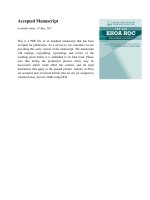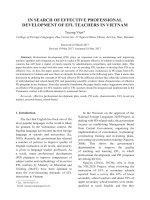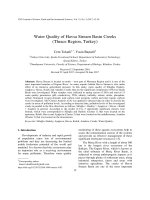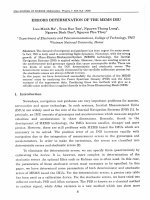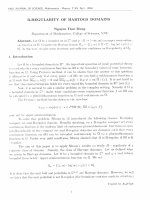DSpace at VNU: Coalgebraic aspects of context-awareness
Bạn đang xem bản rút gọn của tài liệu. Xem và tải ngay bản đầy đủ của tài liệu tại đây (207.58 KB, 7 trang )
Mobile Netw Appl (2013) 18:391–397
DOI 10.1007/s11036-012-0404-0
Coalgebraic Aspects of Context-Awareness
Phan Cong Vinh · Nguyen Thanh Tung
Published online: 26 August 2012
© Springer Science+Business Media, LLC 2012
Abstract This paper will be both to give an in-depth
analysis as well as to present the new material on the
notion of context-aware computing, an idea that computing can both sense and react accordantly based on its
environment. The paper formalizes context-awareness
process using coalgebraic language, including the
coalgebraic definition of context-awareness, bisimulation between context-awarenesses, homomorphism between context-awarenesses and context-awarenesses as
coalgebras. Discussions for further development based
on this approach are also given.
Keywords context-awareness · context-aware
computing
1 Introduction
In design of context-aware systems, one of the limitations of the current design approaches is that when
increasing (fully or partially) the context-awareness of
computing, the semantics and understanding of the
context-awareness process become difficult to capture
for the design [18]. As motivation, the context-awareness
process should be carefully considered under a suitably
rigorous mathematical structure to capture its semantics completely, and then support an automatic design
process, in particular, and applications of context-aware
computing, generally [16, 17, 19].
Both initial algebras and final coalgebras are mathematical tools that can supply abstract representations
to aspects of the context-awareness process [17]. On
the one hand, algebras can specify the operators and
values. On the other hand, coalgebras, based on a collection of observers, are considered in this paper as
a useful framework to model and reason about the
context-awareness process. Both initiality and finality
give rise to a basis for the development of contextawareness calculi directly based on and driven by the
specifications. From a programming point of view, this
paper provides coalgebraic structures to develop the
applications in the area of context-aware computing.
A coalgebraic structure provides an expressive, powerful and uniform view of context-awareness, in which
the observation of context-awareness processes plays a
central role. The concepts of bisimulation and homomorphism of context-awareness are used to compute
the context-awareness process.
2 Outline
P. Cong Vinh ( )
IT Department, NTT University, 300A Nguyen Tat Thanh
St., Ward 13, District 4, HCM City, Vietnam
e-mail:
N. Thanh Tung
International School, Vietnam National University in Hanoi,
144 Xuan Thuy St., Cau Giay District, Hanoi, Vietnam
e-mail:
The paper is a reference material for readers who
already have a basic understanding of context-aware
systems and are now ready to know the novel approach
for formalizing context-awareness in context-aware systems using coalgebraic language.
Formalization is presented in a straightforward fashion by discussing in detail the necessary components
392
and briefly touching on the more advanced components. Some significant coalgebraic aspects, including
justifications needed in order to achieve the particular
results, are presented.
The rest of this paper is organized as follows:
Section 3 briefly describes related work and existing
concepts. Coalgebraic definition of context-awareness
is the subject of Section 4. Section 5 presents relation
of bisimulation between context-awarenesses. Homomorphism between context-awarenesses is investigated
in Section 6. We consider context-awarenesses as coalgebras in Section 7. In Section 8, we briefly discuss
our further development. Finally, Section 9 is a brief
summary.
Mobile Netw Appl (2013) 18:391–397
4 Coalgebraic definition of context-awareness
Definition 1 (Context-Awareness) Let T be a (finite or
infinite) set of contexts. A context-awareness with set
of contexts T is a pair SYS, oSYS , eSYS consisting of
–
–
–
where
–
–
3 Related work and existing concepts
Most notions and observations of this paper are instances of a theory called universal coalgebra [5, 12].
In [11, 14], some recent developments in coalgebra are
presented.
The programming paradigm with functions called
functional programming [1, 3, 4, 7, 9] treats computation as the evaluation of mathematical functions.
Functional programming emphasizes the evaluation of
functional expressions. The expressions are formed by
using functions to combine basic values.
The notion of bisimulation is a categorical generalization that applies to many different instances of
infinite data structures, various other types of automata, and dynamic systems [5, 11, 12]. In theoretical computer science, a bisimulation is an equivalence
relation between abstract machines, also called the
abstract computers or state transition systems (i.e., a
theoretical model of a computer hardware or software
system) used in the study of computation. Abstraction
of computing is usually considered as discrete time
processes. Two computing systems are bisimular if, regarding their behaviors, each of the systems “simulates”
the other and vice-versa. In other words, each of the
systems cannot be distinguished from the other by the
observation.
Homomorphism is one of the fundamental concepts
in abstract algebra [10], which scrutinizes the sets of
algebraic objects, operations on those algebraic objects,
and functions from one set of algebraic objects to
another. A function that preserves the operations on
the algebraic objects is known as a homomorphism. In
other words, if an algebraic object includes several operations, then all its operations must be preserved for a
function to be a homomorphism in that category [8, 15].
a set SYS of states,
an output function oSYS : SYS −→ (T −→ 2), and
an evolution function eSYS : SYS −→ (T −→
SYS).
2 = {0, 1},
oSYS assigns, to a state c, a function oSYS (c) :
T −→ 2, which specifies the value oSYS (c)(t) that
is reached after a context t has been developed. In
other words,
oSYS (c)(t) =
–
1 when t becomes fully available, or
0 otherwise
Similarly, eSYS assigns, to a state c, a function
eSYS (c) : T −→ SYS, which specifies the state
eSYS (c)(t) that is reached after a context t has been
t
developed. Sometimes c −→ c is used to denote
eSYS (c)(t) = c .
Generally, both the state space SYS and the set
T of contexts may be infinite. If both SYS and T
are finite, then we have a finite context-awareness,
otherwise we have an infinite context-awareness. The
function oSYS , eSYS can be explained as detailed from
two different aspects of context-awareness, using an
analysis and universal view, below.
4.1 Analysis view of context-awareness
The function oSYS , eSYS is a tool or technology for
building the context-awareness process. The set of contexts T as input data flow join with the state information of a state-based structure, denoted by SYS, to
built up the context-awareness process that will eventually modify the state information, thus influencing the
change in more later states.
In the denoting way as same as functional programming, the set of functions T −→ 2 is denoted by 2T
and the set of functions T −→ SYS by SYST . In other
words, 2T = { f | f : T −→ 2} and SYST = {g|g : T −→
SYS}. Therefore, the signature of oSYS , eSYS becomes
oSYS , eSYS : SYS −→ (2 × SYS)T
(1)
Mobile Netw Appl (2013) 18:391–397
393
We recognize that context-awareness process represented by function eSYS : SYS −→ SYST does not
apply in all cases. This is expressed by observing the
output of eSYS in a more refined context: SYS is replaced by 1 + SYS, where 1 = {∗} containing an exception value, and eSYS : SYS −→ (1 + SYS)T is a partial
function returning either a valid output or an exception
value, in which the outcome of eSYS is deadlocked, in
the sense that the evolution of the context-awareness
observed in the state space can be undefined. In other
words, if function eSYS (c) in (1 + SYS)T and context t
in T cause eSYS (c)(t) = ∗ then it means that eSYS (c) is
undefined in t, simply denoted by eSYS (c)(t)∗ .
not only by an external input specification, but also
by the internal state in the state-based structure to
which there is no direct access in general. Such contextawarenesses are inherently dynamic and have an observable behavior, but their internal states remain
hidden and have therefore to be identified if not distinguishable by observation. Our approaches throughout
the paper to model and calculate context-awarenesses
are characterized by:
–
–
A state space, which evolves and persists in time;
Interaction with environment during the contextawareness process;
4.2 Universal view of context-awareness
The function oSYS , eSYS can suggest an alternative
model for context-awareness. Instead of using this to
build the context-awareness process, context-awareness
processes and their evolution can be observed. These
can give rise to different context-awareness forms
and the context-awareness processes must thus be
scrutinized.
The universal view will equip itself with the right
“glass”—that is a tool with which to observe and which
necessarily gives rise to a particular “shape” for observation. The relation be specified is between the
input data flow as a set of contexts and the output
states depending on the particular kind of observation
we want to perform. In other words, our focus becomes the universe or, more pragmatically, the state
space. The observed state being produced from the
context-awareness is just one among other possible
observations. The basic concepts required to support an
observation of context-awareness processes consist of:
5 Bisimulation between context-awarenesses
–
A glass:
–
An observation structure: state space −−−−−−→
state space
–
–
oSYS ,eSYS
Informally, the glass can be thought of as providing a
shape which oSYS , eSYS is able to deal with in each of
the above mentioned situations. From a technical point
of view, as this paper aims to make clear, the pair state
space, oSYS , eSYS , as above, constitutes a coalgebra
with interface . Coalgebras provide uniform models
for context-awareness processes.
Differently from the algebraic approach to the operations, which are completely defined by a set of
operators, context-awarenesses we scrutinize here are
specified by determining their behavior. This is done
Definition 2 A bisimulation between two contextawarenesses SYS, oSYS , eSYS
and SYS , oSYS ,
eSYS is a relation R ⊆ SYS × SYS with, for all c
in SYS, c in SYS and t in T
if c R c then
oSYS (c)(t) = oSYS (c )(t) and
eSYS (c)(t) R eSYS (c )(t).
In other words,
if c, c ∈ R then
oSYS (c)(t) = oSYS (c )(t)
and
eSYS (c)(t), eSYS (c )(t) ∈ R.
Two states that are related by a bisimulation relation
are observationally indistinguishable in that:
They give rise to the same observations, and
Applying the same context on both states will lead
to two new states that are indistinguishable again.
The only thing we can observe about state of a contextawareness is whether it is 1 or 0 in 2. We can offer a
context that leads to a new state. For this new state, we
can of course observe again whether it is 1 or 0.
A bisimulation between SYS, oSYS , eSYS and itself is called a bisimulation on SYS, oSYS , eSYS . We
write c ∼ c whenever there exists a bisimulation R
with c R c .
Proposition 1 Union (denoted by ∪) of bisimulations
on SYS, oSYS , eSYS is a bisimulation.
394
Mobile Netw Appl (2013) 18:391–397
Proof In fact, if R1 ⊆ SYS × SYS and R2 ⊆ SYS ×
SYS are any two bisimulations then R1 ∪ R2 is also
bisimulation because every x, y ∈ R1 ∪ R2 is either
x, y ∈ R1 or x, y ∈ R2 . In other words, it is formally
denoted by
R1 ∪ R2 = { x, y | x R1 y or x R2 y}
h
DPGA
c
c’=h(c)
t
t
DPGA’
e(c’)=e(h(c))
e(c)
h
Fig. 1 Commutative diagram of the homomorphism h
Proposition 2 Given bisimulations R1 ⊆ SYS × SYS
and R2 ⊆ SYS × SYS , the relational composition of
R1 with R2 denoted R1 ◦ R2 is a bisimulation.
Proof In fact, the relational composition of two bisimulations R1 ⊆ SYS × SYS and R2 ⊆ SYS × SYS
is the bisimulation obtained by
R1 ◦ R2 = { x, y | x R1 z and z R1 y for some z ∈ SYS }
Definition 3 The union of all bisimulations on SYS,
oSYS , eSYS is the greatest bisimulation. The greatest
bisimulation is called the bisimulation equivalence or
bisimilarity [11], again denoted by the operation ∼.
Proposition 3 The
relation.
bisimilarity
is
an
equivalence
Proof In fact, a bisimilarity on a set of states SYS is a
binary relation on SYS that is reflexive, symmetric and
transitive; i.e., it holds for all a, b and c in SYS such that
–
–
–
(Reflexivity) a ∼ a
(Symmetry) if a ∼ b then b ∼ a
(Transitivity) if a ∼ b and b ∼ c then a ∼ c
Definition 5 A context-awareness SYS, oSYS , eSYS
is a “subcontext-awareness” of SYS , oSYS , eSYS if
SYS ⊆ SYS and the inclusion function i : SYS −→
SYS (i.e., i(c) = c) is a homomorphism.
For a state c in SYS , let c denote the subcontextawareness generated by c .
Proposition 4 c is the smallest subcontext-awareness
of SYS containing c .
Proof This can be obtained by including all states from
SYS that are reachable via a finite number of evolutions from c .
Proposition 5 Given SYS , oSYS , eSYS and SYS,
oSYS , eSYS = c , the functions oSYS and eSYS are
uniquely determined.
Proof This follows from Definitions 4 and 5.
Proposition 6 For a homomorphism h : SYS −→
and SYS, oSYS , eSYS is a subcontext-awareness of
SYS , oSYS , eSYS , h(SYS), oh(SYS) , eh(SYS) is a
subcontext-awareness of , o , e .
6 Homomorphism between context-awarenesses
Proof This is as a result of the Definitions 4 and 5.
Definition 4 A homomorphism between SYS, oSYS ,
eSYS and SYS , oSYS , eSYS is any function h :
SYS −→ SYS with, for all c in SYS and t in T
Proposition 7 For a homomorphism h : SYS −→
and c in SYS , h( c ) = h(c ) .
–
–
oSYS (c)(t) = oSYS (h(c))(t) and
h(eSYS (c)(t)) = eSYS (h(c))(t)
We can use a commutative diagram as a diagram of
objects and homomorphisms such that, when picking
two objects, we can follow any path through the diagram and obtain the same result by composition (see
Fig. 1).
Proof This is a result of the Definitions 4 and 5.
The notions of context-awareness, homomorphism
and bisimulation are closely related, in fact
Proposition 8 The function h : SYS −→ SYS is a homomorphism if f its relation R = { c, h(c) | c ∈ SYS} is
a bisimulation.
Mobile Netw Appl (2013) 18:391–397
395
Proof Firstly, prove that homomorphism h =⇒ R =
{ c, h(c) } is a bisimulation. In fact, the homomorphism
of h is given by h(eSYS (c)(t)) = eSYS (h(c))(t) and
oSYS (c)(t) = oSYS (h(c))(t) = oSYS (c )(t). Thus, if every
eSYS (c)(t), h(eSYS (c)(t)) is in R ⊆ SYS × SYS then
eSYS (c)(t), eSYS (h(c))(t) is also in R. In other words,
this is eSYS (c)(t), eSYS (c )(t) in R. R is a bisimulation.
Finally, prove the opposite way that the bisimulation of R = { c, h(c) } =⇒ h is a homomorphism.
In fact, the results of bisimulation are oSYS (c)(t) =
oSYS (h(c))(t) = oSYS (c )(t) and eSYS (c)(t), eSYS (h(c))(t)
in R. This gives rise to a definition as h(eSYS (c)(t)) =
eSYS (h(c))(t). Thus, h is a homomorphism.
Proposition 9 Bisimulations are themselves contextawarenesses.
Proof If R is a bisimulation between SYS and SYS ,
then o R : R −→ 2T and e R : R −→ RT . For c, c in R
and t in T, the functions of o R and e R given by o R ( c,
c )(t) = oSYS (c)(t), oSYS (c )(t) and e R ( c, c )(t) =
eSYS (c)(t), eSYS (c )(t) , define a context-awareness R,
oR, eR .
7 Context-awarenesses as coalgebras
7.1 Interfaces
The context-awareness SYS, oSYS , eSYS is considered as the structure observed through the following
interface.
= (2 × __)T
(2)
Applying this interface to the observable state space
SYS, we have
SYS = (2 × SYS)T
(3)
This interface of
can be regarded as a mapping to
decompose the observable state space SYS into an
observation context (2 × __)T of the state space.
Context-awarenesses are coalgebras of the functor
, which is defined on sets SYS by
SYS = (2×
SYS)T . Now for a context-awareness SYS, oSYS ,
eSYS , the functions oSYS : SYS −→ 2T and eSYS :
SYS −→ SYST can be combined into one function
oSYS , eSYS : SYS −→ (2 × SYS)T , which maps c in
SYS into the pair oSYS (c), eSYS (c) . In this way,
the context-awareness SYS, oSYS , eSYS has been
represented as a -coalgebra oSYS , eSYS : SYS −→
SYS. Through this coalgebraic representation of
context-awarenesses, there exist a number of notions
and results on coalgebras in general, which can now be
applied to context-awarenesses. Notably there are two
Definitions 7 and 8 below.
Definition 7 Consider an arbitrary functor T :
SYS −→ SYS and let (SYS, f ) and (SYS , f ) be
two T-coalgebras. A function h : SYS −→ SYS is a
homomorphism of T-coalgebras, or T-homomorphism,
if T h ◦ f = f ◦ h.
In order to apply this definition to the case
of context-awarenesses, we still have to give the
definition of the functor T on functions, which is as
follows. For a function h : SYS −→ SYS , the function
T h : (2 × SYS)T −→ (2 × SYS )T is defined, for any
head(of the stream) in 2T and tail (of the stream)
in SYST by T(h)( head, tail ) = head, h ◦ tail . Now
consider two context-awarenesses, i.e., T-coalgebras,
SYS, oSYS , eSYS and SYS , oSYS , eSYS , where
oSYS , eSYS : SYS −→ T SYS and oSYS , eSYS :
SYS −→ T SYS . According to the definition, a
function h : SYS −→ SYS is a homomorphism of
T-coalgebras if T h ◦ oSYS , eSYS = oSYS , eSYS ◦ h,
which is equivalent to oSYS (c)(t) = oSYS (h(c))(t) and
h(eSYS (c)(t)) = eSYS (h(c))(t), for all c and t. Note that
this is precisely the definition of homomorphism.
The commutativity is represented by the following
diagram:
SYS
f = oSYS ,tSYS
Th
h
7.2 Coalgebras
Definition 6 Let : SYS −→ SYS be a functor on the
category of states and functions. A -coalgebra is a
pair SYS, f consisting of a set SYS and a function
f : SYS −→ SYS.
❄
SYS
✲ (2 × SYS)T
f = oSYS ,tSYS
❄
✲ (2 × SYS )T
Definition 8 A relation R ⊆ SYS × SYS is called a
T-bisimulation between T-coalgebras SYS, f and
SYS , f if there exists a T-coalgebra structure g :
396
Mobile Netw Appl (2013) 18:391–397
R −→ T R on R such that the projections π1 : R −→
SYS and π2 : R −→ SYS are T-homomorphisms.
The commutativity is represented by the following
diagram:
SYS ✛
π1
f
❄
T SYS ✛
R
π2
f’
g
T π1
❄
TR
✲ SYS
T π2
❄
✲ T SYS
For a functor T : SYS −→ SYS, the family of Tcoalgebras together with the T-homomorphisms between them, forms a category [15]. In this category, a
coalgebra ( , f ) is final if there exists from any coalgebra precisely one homomorphism into ( , f ). The interest of final coalgebras lies in the fact that they satisfy the
following coinduction proof principle [11, 13]: if there
exists a T-bisimulation between γ and γ in then γ
and γ are equal. This follows the finality of ( , f ).
8 Discussions
The aim of this paper has been both to give an indepth analysis as well as to present the new material on the notion of context-aware computing. In this
section, we briefly discuss our further development.
By our approach, the notion of Aspect/ComponentOriented model for context-aware computing has
been introduced, in which contextware is oriented by
“aspect” development and stateware is oriented by
“component” approach. Aspect-Oriented Contextware
relies on “separation of concerns” in all phases of the
contextware development lifecycle, while ComponentOriented Stateware greatly depends on pre-fabricated
“components” for building the data processing needs of
stateware. Incorporating both the emerging programming approaches based on aspect [6] and component [2]
could unify the two specialized concepts of “modularity” and “separation of concerns” in model.
9 Conclusions
In this paper, we have rigorously approached to the
notion of context-awareness in context-aware systems
from which coalgebraic aspects of the context-awareness
emerge. The coalgebraic model is used to formalize the
unifying frameworks for context-awareness and evolution of the context-awareness processes, respectively.
Acknowledgements Thank you to NTTUFSTD1 for the constant support of our work which culminated in the publication of
this paper. As always, we are deeply indebted to the anonymous
reviewers for their helpful comments and valuable suggestions
which have contributed to the final preparation of the paper.
References
1. Barbosa LS (2000) Components as processes: an exercise in
coalgebraic modeling. In: Smith SF, Talcott CL (eds) 4th
international conference on formal methods for open objectbased distributed systems, IFIP TC6/WG6.1, 6–8 September
2000. Kluwer Academic Publishers, Stanford, CA, USA,
pp 397–417
2. Barbosa LS, Liu Z (eds) (2005) Proceedings of the 2nd international workshop on formal aspects of component software
(FACS), Macao, 24–25 October 2005. UNU/IIST. ENTCS
3. Cockett R, Spencer D (1991) Strong categorical datatypes I.
In: Seely RAG (ed) International summer meeting on category theory, AMS Canadian Mathematical Society, 23–30
June 1991. AMS, Montréal, Québec, Canada, pp 141–169
4. Hagino T (1987) A typed lambda calculus with categorical type constructors. In: Pitt DH, Poigné A, Rydeheard
DE (eds) Category theory and computer science, September
1987. Lecture notes in computer science, vol 283. Springer–
Verlag, Edinburgh, UK, pp 140–157
5. Jacobs B, Rutten J (1997) A tutorial on (Co)Algebras and
(Co)Induction. Bulletin of EATCS 62:222–259
6. Kiczales G, Lamping J, Menhdhekar A, Maeda C, Lopes C,
Loingtier JM, Irwin J (1997) Aspect-oriented programming.
In: Ak¸sit M, Matsuoka S (eds) 11th European conference
on object-oriented programming (ECOOP), 10 June 1997.
Lecture notes in computer science, vol 1241. The paper originating AOP, Springer–Verlag, Jyväskylä, Finland, pp 220–
242
7. Kieburtz RB (1998) Reactive functional programming. In:
Gries D, Roever WPde (eds) Programming concepts and
methods (PROCOMET), IFIP international federation for
information processing, 8–12 June 1998. Chapman and Hall,
Shelter Island, NY, USA, pp 263–284
8. Levine M (1998) Categorical algebra. In: Benkart G, Ratiu
TS, Masur HA, Renardy M (eds) Mixed motives, mathematical surveys and monographs, vol 57, chapter I, II, II of part
II, American Mathematical Society, USA, pp 373–499
9. Meijer E, Fokkinga M, Paterson R (1991) Functional programming with bananas, lenses, envelopes and barbed wire.
In: Hughes J (ed) ACM conference on functional programming languages and computer architecture, 26–30 August
1991. Lecture notes in computer science, vol 523. Springer–
Verlag, Cambridge, MA, USA, pp 124–144
10. Rotman JJ (2002) Advanced modern algebra, 1st edn.
Prentice Hall, USA
11. Rutten JJMM (1998) Automata and coinduction (an exercise in coalgebra). In: 9th international conference on concurrency theory (CONCUR), 8–11 September 1998. Lecture
notes in computer science, vol 1466. Springer–Verlag, Nice,
France, pp 194–218
12. Rutten JJMM (2000) Universal coalgebra: a theory of systems. Theor Comp Sci 249(1):3–80
1 The
NTTU
Development.
foundation
for
Science
and
Technology
Mobile Netw Appl (2013) 18:391–397
13. Rutten JJMM (2001) Elements of stream calculus (an extensive exercise in coinduction). In: Proceedings of the 17th
annual conference on mathematical foundations of programming semantics (MFPS ’01), Aarhus, Denmark, ENTCS,
vol 45. Elsevier Science B.V., 66 p
14. Rutten JJMM (2005) Algebra, bitstreams, and circuits.
Technical Report SEN-R0502, CWI, Amsterdam, The
Netherlands
15. van Oosten J (2002) Basic category theory. Department of
Mathematics, Utrecht University, The Netherlands
16. Vinh PC (2009) Autonomic computing and networking,
chapter formal aspects of self-* in autonomic networked computing systems. Springer, pp 381–410
397
17. Vinh PC (2009) Dynamic reconfigurability in reconfigurable
computing systems: formal aspects of computing, 1st edn.
VDM Verlag, 236 p
18. Vinh PC (2011) Formal and practical aspects of autonomic
computing and networking: specification, development, and
verification, chapter formal specification and verification of
self-configuring p2p networking: a case study in mobile environments, 1st edn. IGI Global, pp 170–188
19. Vinh PC (2012) Data intensive distributed computing in data
aware self-organizing networks. In: Transactions on computational science XV: special issue on advances in autonomic
computing: formal engineering methods for nature-inspired
computing systems. Springer, Berlin, pp 74–107


